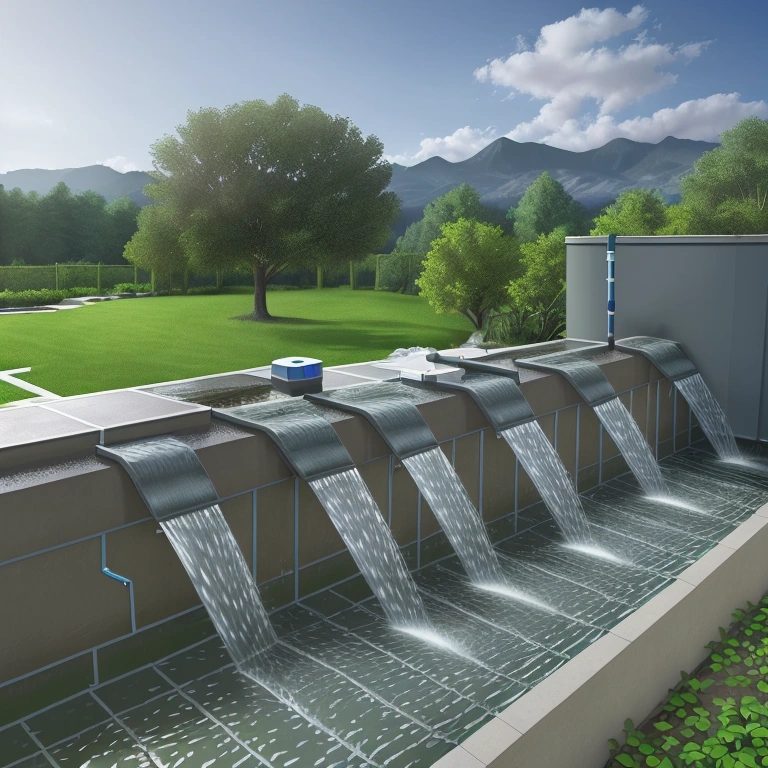Comprehensive Guide: Implementing Advanced Rainwater Harvesting and Filtration Systems for Sustainable Living
The Rain Revolution: From Niche to Necessity
In an era defined by increasing environmental consciousness and the looming specter of water scarcity, rainwater harvesting has emerged from a niche practice to a mainstream solution. No longer relegated to the fringes of sustainability, it’s now viewed as a pragmatic approach to resource management, embraced by homeowners, businesses, and even municipalities. But simply collecting rainwater is no longer sufficient. The modern imperative demands sophisticated systems that not only capture this precious resource but also purify it to meet stringent quality standards.
From sprawling suburban landscapes to the dense urban core, the integration of advanced rainwater harvesting and filtration technologies is reshaping our relationship with water. Rainwater harvesting, once a rudimentary practice, now stands as a cornerstone of sustainable living, offering a tangible pathway to water conservation and reduced reliance on centralized water supplies. The shift towards more sophisticated rainwater collection systems is fueled by a growing awareness of the environmental impact associated with traditional water management practices.
Pumping, treating, and distributing water over vast distances consumes significant energy, contributing to greenhouse gas emissions. By embracing rainwater harvesting, individuals and communities can minimize their carbon footprint while simultaneously bolstering their water security, especially crucial for those pursuing off-grid water solutions. The advancements in water filtration technologies have been pivotal in transforming rainwater from a supplementary source to a viable alternative for potable and non-potable uses. Modern filtration systems, incorporating multi-stage processes such as sediment filtration, activated carbon filtration, and UV disinfection, can effectively remove contaminants and pathogens, ensuring that harvested rainwater meets stringent water quality standards.
This is particularly relevant for individuals seeking to establish self-sufficient, off-grid systems, where access to reliable and safe water sources is paramount. Regular water quality testing becomes an indispensable element in maintaining the integrity of these systems and safeguarding public health. The integration of rainwater harvesting into green building design is further accelerating its adoption. Architects and developers are increasingly incorporating rainwater collection and filtration systems into new construction projects, recognizing their potential to contribute to LEED certification and enhance the overall sustainability profile of buildings. These systems not only reduce water consumption but also alleviate pressure on municipal water infrastructure, particularly during peak demand periods. As concerns about water sustainability continue to escalate, rainwater harvesting is poised to become an even more integral component of responsible resource management strategies, driving innovation and fostering a more resilient and water-conscious society.
Above or Below? Designing the Optimal Storage System
The architecture of a rainwater harvesting system hinges on two primary storage paradigms: above-ground and below-ground. Above-ground tanks, typically constructed from polyethylene, fiberglass, or concrete, offer ease of installation and visual monitoring, making them a popular choice for retrofitting existing structures and simpler rainwater collection setups. However, they can be susceptible to temperature fluctuations, potentially impacting water quality and requiring careful aesthetic integration into the surrounding environment to align with principles of sustainable living and green building.
Below-ground tanks, often made from concrete or durable plastic, provide thermal stability, conserving space and minimizing visual impact, crucial for maximizing property value and adhering to community aesthetics. However, they necessitate more complex installation procedures and may require excavation permits, adding to the initial cost of the rainwater harvesting system. The choice between these options depends on site-specific constraints, aesthetic preferences, budget considerations, and long-term water sustainability goals. Beyond storage material and location, the placement of the tank significantly impacts water quality.
Shaded locations minimize algae growth and maintain cooler water temperatures, vital for long-term storage and reducing the burden on subsequent water filtration systems. Orienting the tank to minimize direct sunlight exposure is a simple yet effective strategy for water conservation. Consider integrating a ‘smart’ tank monitoring system that provides real-time data on water levels, temperature, and even preliminary water quality indicators. Such systems, increasingly common in off-grid water solutions, allow for proactive management and can alert homeowners to potential issues before they escalate.
These insights can optimize water usage and inform decisions about supplementary water sources, enhancing the overall efficiency and resilience of the rainwater harvesting setup. Furthermore, the decision between above-ground and below-ground storage can significantly affect the overall cost-effectiveness of the rainwater harvesting system. While above-ground tanks generally have lower upfront installation costs, they may require additional insulation or shading to maintain optimal water temperatures, adding to long-term expenses. Below-ground tanks, while more expensive to install, offer superior thermal stability and can potentially reduce the need for extensive water quality testing due to the reduced risk of algae growth and bacterial contamination. Ultimately, a comprehensive cost-benefit analysis, considering factors such as local climate, water usage patterns, and long-term maintenance requirements, is crucial for determining the most sustainable and economically viable storage solution for each specific application. A well-designed rainwater harvesting system contributes significantly to water conservation efforts and promotes a more resilient and environmentally conscious lifestyle.
The First Line of Defense: Pre-Filtration Techniques
Before rainwater even reaches the storage tank, a series of pre-filtration steps are crucial for optimal rainwater harvesting. Leaf screens, strategically positioned at the entry points of gutters and downspouts, prevent large debris such as leaves, twigs, and animal matter from entering the system. These simple yet effective devices significantly reduce the organic load on subsequent water filtration stages, minimizing the risk of clogging and prolonging the lifespan of more sophisticated filters. Regular inspection and cleaning of leaf screens are paramount, especially during periods of heavy leaf fall.
As John Thompson, a leading expert in off-grid water solutions, notes, “Neglecting this initial step is akin to inviting a cascade of problems downstream. A clean screen is the cornerstone of a healthy rainwater collection system.” First-flush diverters, a more sophisticated component, divert the initial runoff from each rainfall event, which typically contains the highest concentration of contaminants accumulated from the roof surface. This ‘first flush’ often carries pollutants such as bird droppings, atmospheric dust, and chemical residues.
Diverters range from simple manual valves to automated systems that sense the amount of rainfall and divert the appropriate volume. The effectiveness of a first-flush diverter is directly proportional to its design and the accuracy of its calibration. For instance, a study by the Water Research Foundation found that properly sized first-flush diverters can reduce the concentration of E. coli in harvested rainwater by up to 90%, significantly enhancing water sustainability. Beyond leaf screens and first-flush diverters, other pre-filtration techniques can further enhance water quality.
Gravel filters, often incorporated into the downspout system, provide an additional layer of coarse filtration, removing larger sediment particles. Vortex filters utilize centrifugal force to separate debris from the water stream, offering a compact and efficient pre-filtration solution. The choice of pre-filtration methods depends on factors such as the size of the roof, the local climate, and the intended use of the harvested rainwater. Implementing a multi-layered pre-filtration strategy not only protects downstream filtration systems but also contributes significantly to the overall water conservation efforts and promotes sustainable living. Regular maintenance of these pre-filtration devices is essential to prevent clogging and maintain their effectiveness; failing to do so can compromise the entire rainwater harvesting system. The Uzbekhistan and IAEA cooperation on nuclear infrastructure underlines the importance of long-term planning and maintenance; a principle equally applicable to rainwater harvesting and ensuring long-term water quality testing.
Advanced Filtration: Achieving Potable Water Quality
Achieving potable water quality from rainwater harvesting requires a multi-stage filtration process tailored to sustainable living and off-grid water systems. Slow sand filters, a time-tested technology particularly valuable for water conservation, utilize a biological layer (Schmutzdecke) to remove pathogens and particulate matter. These filters are especially effective in removing turbidity, a common issue in rainwater collection, and contribute significantly to overall water sustainability. UV disinfection systems employ ultraviolet light to neutralize bacteria and viruses, providing an effective and chemical-free method of sterilization, a crucial aspect for off-grid systems seeking independence from chemical treatments.
Ceramic filters, with their micro-porous structure, further remove sediment, bacteria, and protozoa, enhancing the water’s clarity and safety. The selection and configuration of these filtration methods depend on the intended use of the harvested rainwater and the desired level of purity. For potable applications, a combination of filtration and disinfection is typically recommended to meet stringent water quality testing standards. The recent Vietnamese and Malaysian PMs meeting highlights the importance of collaborative solutions; similarly, optimizing water filtration requires integrating different technologies.
Beyond these core methods, alternative and supplementary filtration techniques play a vital role in comprehensive rainwater harvesting systems. Activated carbon filters excel at removing chlorine, volatile organic compounds (VOCs), and other chemicals that may affect taste and odor, making the water more palatable and safe for consumption. These filters are particularly relevant in urban environments where rainwater may be exposed to atmospheric pollutants. Furthermore, reverse osmosis (RO) systems, while more complex and energy-intensive, can remove dissolved salts and minerals, producing highly purified water suitable for sensitive applications like hydroponics or specialized medical needs within a sustainable living context.
The choice of incorporating RO depends on the specific water quality goals and the availability of renewable energy sources to power the system in an off-grid setting. For those committed to green building practices and water conservation, integrating a monitoring system into the advanced filtration setup is essential. Real-time water quality testing provides continuous feedback on the system’s performance, allowing for prompt adjustments and maintenance to ensure consistent purity. Sensors can track parameters such as pH, turbidity, and chlorine levels, alerting users to potential issues before they compromise water safety. This proactive approach not only safeguards water quality but also optimizes the lifespan and efficiency of the filtration components, reducing waste and minimizing environmental impact. Data from these monitoring systems can also be used to optimize the filtration process, further enhancing water sustainability and promoting responsible water management practices within the framework of rainwater harvesting.
Ensuring Purity: Water Quality Testing Protocols
Regular water quality testing is paramount to ensure the safety and suitability of harvested rainwater, especially when considering its use within the broader context of sustainable living and off-grid water systems. Testing protocols should include analysis for pH, turbidity, bacteria (E. coli, coliforms), and heavy metals, as these factors directly impact the water’s potability and overall usability. Simple test kits are available for basic on-site analysis, enabling homeowners to conduct preliminary assessments of their rainwater collection.
However, for a more comprehensive understanding of water safety, accredited laboratories can provide detailed analyses, identifying a wider range of potential contaminants and ensuring adherence to established water quality standards. The selection of testing methods should align with the intended use of the water, with potable applications demanding more rigorous and frequent evaluations. The frequency of water quality testing depends significantly on several factors, including the local environmental conditions, the type of rainwater harvesting system employed, and the intended use of the harvested water.
For potable water applications within off-grid systems, monthly testing for bacteria is strongly recommended, alongside periodic checks for chemical contaminants and heavy metals, ideally conducted quarterly or bi-annually. In contrast, water used solely for irrigation or non-potable purposes may require less frequent testing. Furthermore, it’s crucial to conduct thorough testing after any significant maintenance or repairs to the filtration systems, or following periods of heavy rainfall, which can introduce higher levels of contaminants. Consistent monitoring provides a reliable baseline and helps identify any emerging issues promptly.
Maintaining a detailed and accessible record of water quality test results is essential for effective water sustainability management and optimizing the performance of rainwater filtration systems. This record should include the date of each test, the parameters analyzed, the test results, and any corrective actions taken in response to the findings. Over time, this data creates a valuable historical profile of the water quality, allowing for the identification of trends and potential problems. Furthermore, this documentation can be crucial for demonstrating compliance with local regulations and building codes related to rainwater harvesting and green building practices. Sharing these records with qualified professionals can also facilitate informed decision-making regarding system maintenance, upgrades, and adjustments to filtration protocols, ultimately ensuring the long-term safety and reliability of the water supply. Prioritizing water quality testing is not just about ensuring safe drinking water; it’s about embracing a holistic approach to water conservation and responsible resource management.
The Bottom Line: Cost-Effectiveness and Environmental Impact
The financial viability of rainwater harvesting systems is a nuanced calculation, varying significantly based on system size, complexity, local water rates, and perhaps most importantly, the intended use of the harvested water. While the initial investment in rainwater collection, storage, and water filtration can appear substantial – especially when aiming for potable water quality – the long-term cost savings from reduced reliance on municipal water supplies are often significant, particularly in regions with escalating water costs.
Furthermore, government incentives, tax credits, and rebates designed to promote water conservation and green building practices can substantially offset the upfront capital expenditure, improving the return on investment. From an environmental perspective, rainwater harvesting offers a compelling suite of benefits directly aligned with sustainable living principles. By reducing the strain on municipal water supplies, we lessen the energy-intensive processes of water extraction, treatment, and distribution. Decreased stormwater runoff mitigates erosion and reduces the burden on wastewater treatment facilities, further minimizing environmental impact.
For off-grid water solutions, rainwater harvesting represents a cornerstone of self-sufficiency, reducing dependence on centralized infrastructure and promoting resilience in the face of climate change and potential disruptions to conventional water sources. The implementation of advanced filtration systems ensures water sustainability without compromising water quality. To accurately assess the overall value proposition of rainwater harvesting, a comprehensive life-cycle cost analysis is essential. This analysis should consider not only the direct economic benefits but also the indirect environmental and social benefits, such as reduced carbon footprint and enhanced water security.
Furthermore, the analysis should account for the potential revenue streams associated with water conservation, such as selling surplus water back to the grid or using harvested rainwater for irrigation purposes. Regular water quality testing remains paramount, ensuring that the harvested rainwater meets the intended use standards and safeguards public health, while also optimizing the maintenance schedule for filtration systems. Properly designed and maintained rainwater harvesting systems represent a tangible step towards a more sustainable and resilient future.
Practical Advice: Implementation and Maintenance
Successful implementation of rainwater harvesting requires meticulous planning, professional installation, and consistent maintenance to truly unlock its potential for sustainable living. Homeowners and businesses embarking on this journey should first consult with qualified professionals experienced in rainwater collection and water filtration systems. These experts can accurately assess water needs, taking into account factors like roof size, rainfall patterns, and intended water usage (irrigation, toilet flushing, or even potable applications after rigorous water quality testing). A well-designed system will optimize rainwater harvesting efficiency while adhering to local regulations and building codes, ensuring long-term water sustainability.
Regular maintenance is paramount for preserving water quality and maximizing system longevity. This includes routinely cleaning leaf screens and gutters to prevent debris accumulation, which can compromise filtration systems and reduce rainwater collection efficiency. Inspecting and servicing filtration components, such as pre-filters, sediment filters, and UV sterilizers, is equally crucial. Proactive measures, like shock chlorination or ozone treatment, can address potential issues like algae growth and biofilm formation within the storage tank. Furthermore, regular water quality testing, both through DIY kits and accredited laboratories, provides valuable insights into the effectiveness of the filtration process and ensures the water remains safe for its intended use.
Beyond the practical aspects, consider the broader implications for off-grid water solutions and green building practices. Integrating rainwater harvesting into a holistic water conservation strategy can significantly reduce reliance on municipal water supplies, lessening the strain on local resources and promoting environmental stewardship. For those seeking greater self-sufficiency, rainwater harvesting can be combined with other off-grid technologies, such as solar power and greywater recycling, to create a truly sustainable and resilient lifestyle. By embracing rainwater harvesting, individuals and communities can actively contribute to a more water-secure future, demonstrating a commitment to both environmental responsibility and long-term cost savings.
Success Stories: Showcasing Real-World Implementations
From arid regions grappling with drought to water-stressed urban centers, successful implementations of advanced rainwater harvesting systems offer compelling evidence of their potential to revolutionize water management. In Arizona, entire communities demonstrate the viability of large-scale rainwater harvesting for potable and non-potable uses, showcasing how off-grid water solutions can ensure water sustainability even in the harshest climates. Seattle’s commercial buildings exemplify another approach: integrating rainwater collection for toilet flushing and irrigation to drastically cut municipal water dependence.
These case studies underscore rainwater harvesting’s adaptability as a cornerstone of green building practices and a crucial element of sustainable living. Beyond these well-known examples, innovative rainwater harvesting projects are emerging globally. In Singapore, sophisticated water filtration systems treat rainwater to meet stringent potable water standards, reducing reliance on imported water and bolstering national water security. According to a recent report by the World Resources Institute, countries that invest in rainwater harvesting and water conservation technologies are significantly more resilient to climate change impacts.
These advanced filtration systems, coupled with responsible water quality testing protocols, are ensuring that harvested rainwater is a safe and reliable resource for communities worldwide. Moreover, the integration of rainwater harvesting into off-grid systems is transforming rural communities. By combining rainwater collection with solar power, these communities can achieve complete water and energy independence, fostering economic development and improving public health. “Rainwater harvesting is not just about collecting water; it’s about empowering communities to take control of their resources and build a more sustainable future,” notes Dr. Emily Carter, a leading expert in water resource management. As technology advances and public awareness grows, rainwater harvesting is poised to play an increasingly vital role in securing our water future, offering a practical and environmentally sound pathway towards water sustainability.


